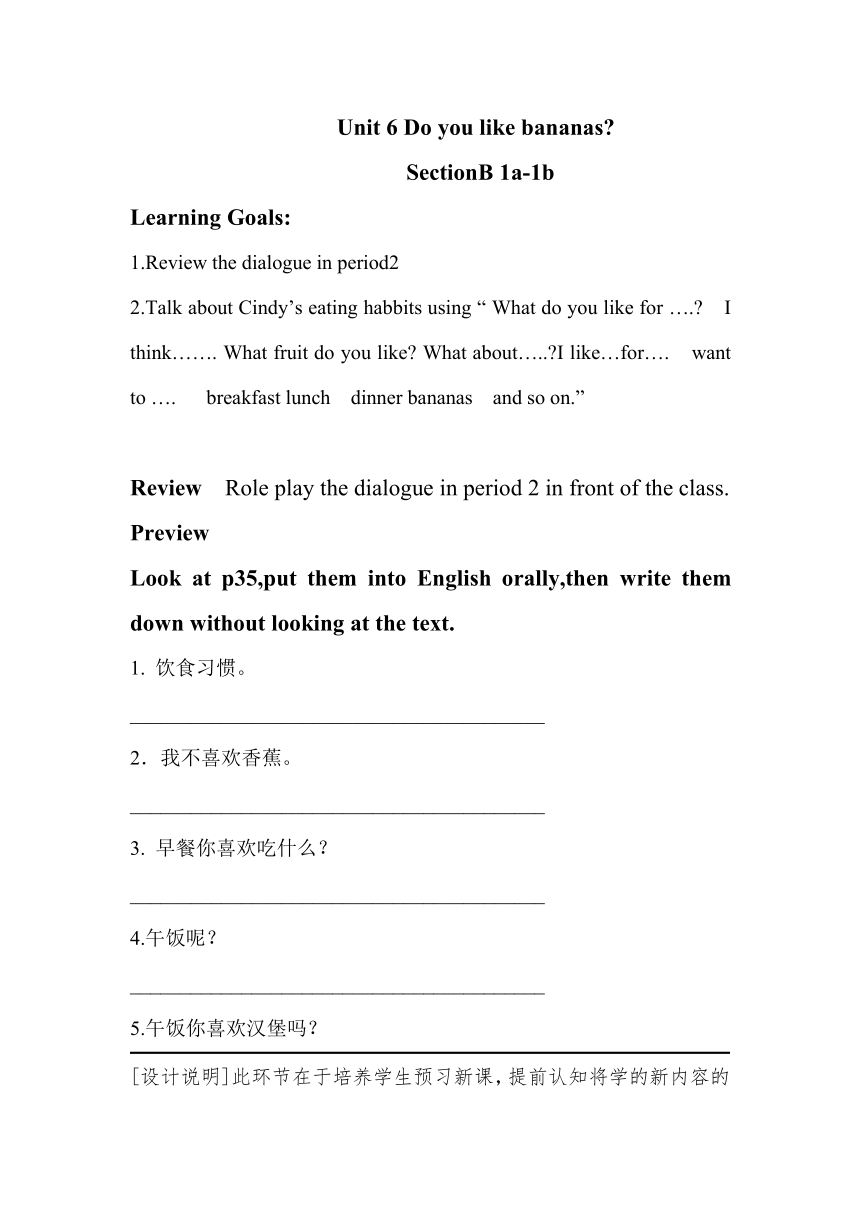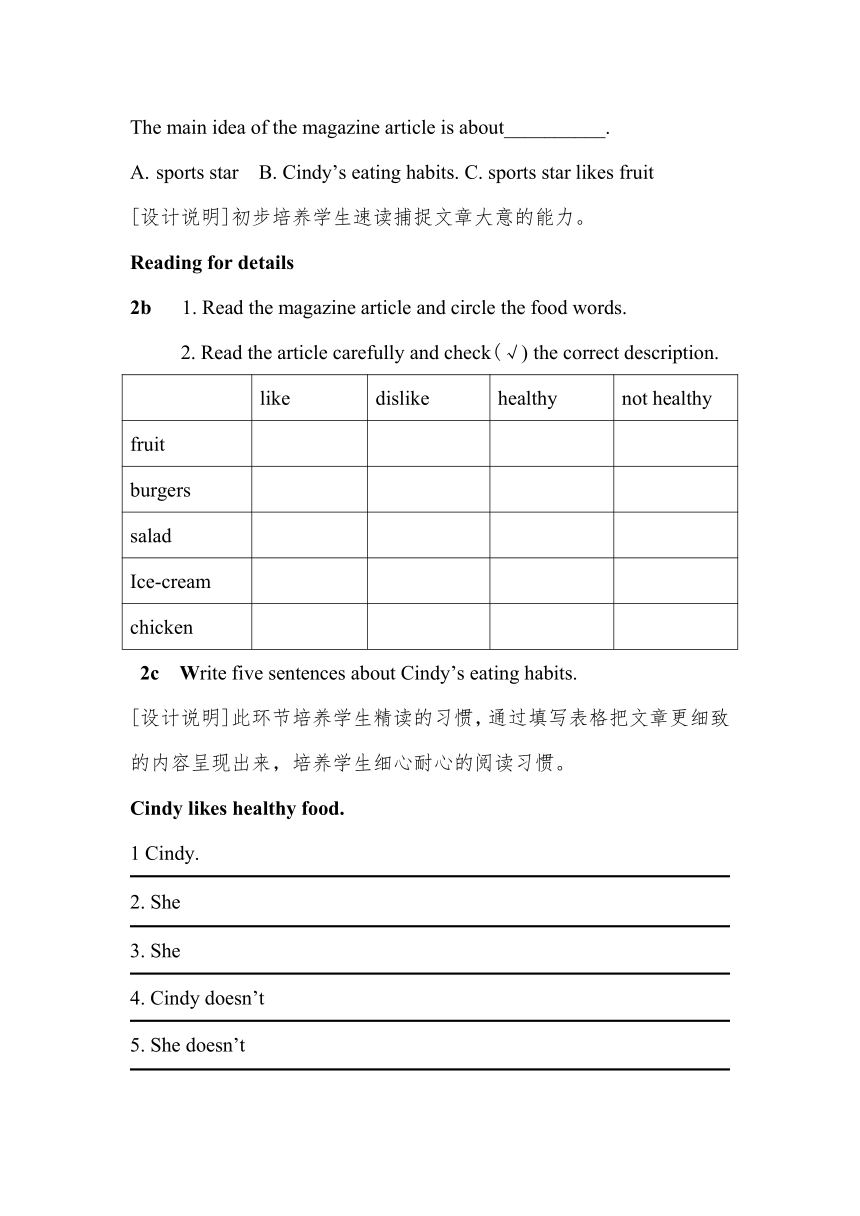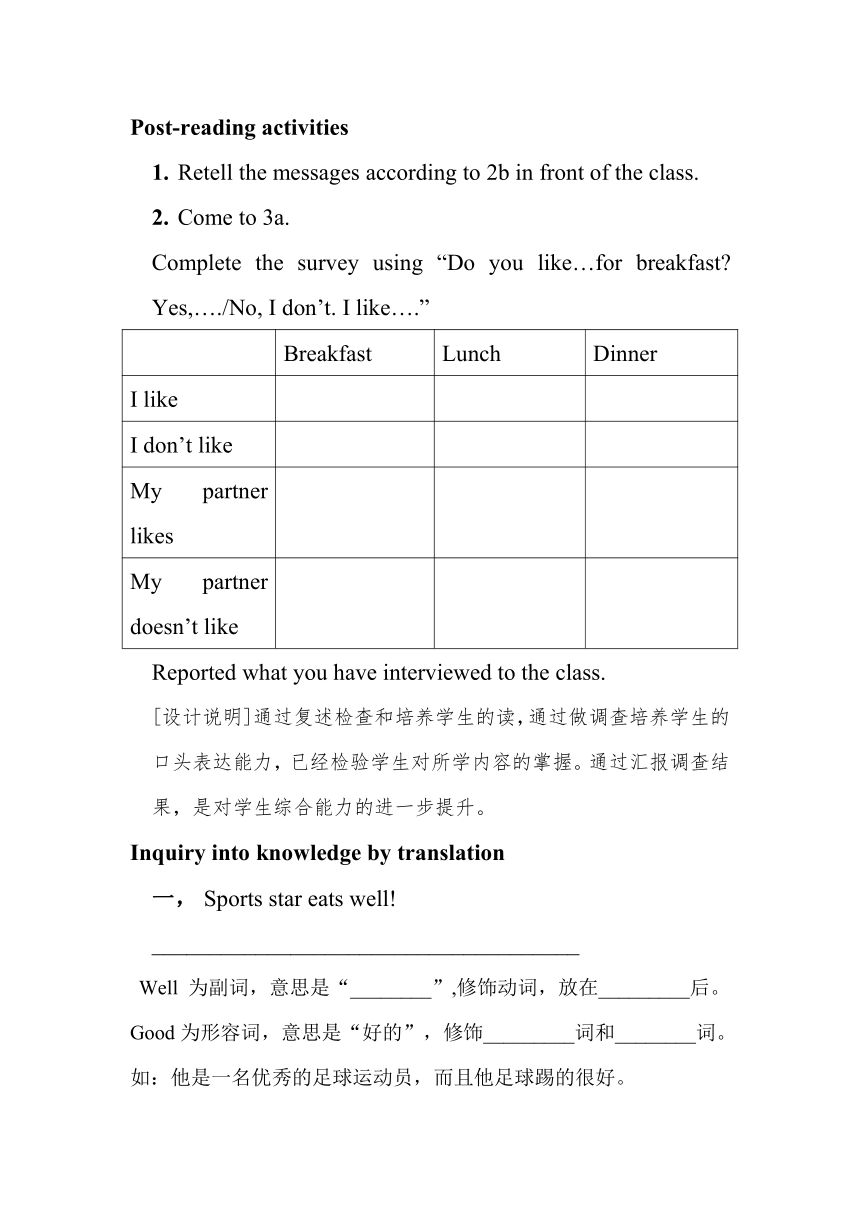Unit 6 Do you like bananas? (SectionB 1a-1b)
文档属性
| 名称 | Unit 6 Do you like bananas? (SectionB 1a-1b) |  | |
| 格式 | zip | ||
| 文件大小 | 17.0KB | ||
| 资源类型 | 教案 | ||
| 版本资源 | 人教新目标(Go for it)版 | ||
| 科目 | 英语 | ||
| 更新时间 | 2013-04-05 14:45:50 | ||
图片预览




文档简介
Unit 6 Do you like bananas?
SectionB 1a-1b
Learning Goals:
1.Review the dialogue in period2
2.Talk about Cindy’s eating habbits using “ What do you like for ….? I think……. What fruit do you like? What about…..?I like…for…. want to …. breakfast lunch dinner bananas and so on.”
Review Role play the dialogue in period 2 in front of the class.
Preview
Look at p35,put them into English orally,then write them down without looking at the text.
1. 饮食习惯。
_________________________________________
2.我不喜欢香蕉。
_________________________________________
3. 早餐你喜欢吃什么?
_________________________________________
4.午饭呢?
_________________________________________
5.午饭你喜欢汉堡吗?
[设计说明]此环节在于培养学生预习新课,提前认知将学的新内容的习惯,这样利用学生发现问题,课堂上的针对性学习能够实现,也是对上节课内容的复习。
Warming up and leading in
P35
T: Hello, everybody! Do you like fruit?
Ss: Yes,…..
T: Is fruit healthy?
Ss: Yes.
T: Do you like hamburgers?
Ss: No,….
T: Are hamburger healthy?
Ss: No,…
T:Do you like ice-cream?
Ss: No,….
T: Is ice-cream healthy?
Ss: Maybe.
T: Some food are healthy,but some are not.Let’s come to 2a.
2a Which food do you think is healthy?Check(√)Yes,Maybe or No.
[设计说明]本堂课热身环节主要让学生们复习上节课的内容,为新学的内容做铺垫。
Read the passage fast and silently to find the general idea.
The main idea of the magazine article is about__________.
sports star B. Cindy’s eating habits. C. sports star likes fruit
[设计说明]初步培养学生速读捕捉文章大意的能力。
Reading for details
2b 1. Read the magazine article and circle the food words.
2. Read the article carefully and check(√) the correct description.
like
dislike
healthy
not healthy
fruit
burgers
salad
Ice-cream
chicken
2c Write five sentences about Cindy’s eating habits.
[设计说明]此环节培养学生精读的习惯,通过填写表格把文章更细致的内容呈现出来,培养学生细心耐心的阅读习惯。
Cindy likes healthy food.
1 Cindy.
2. She
3. She
4. Cindy doesn’t
5. She doesn’t
Post-reading activities
Retell the messages according to 2b in front of the class.
Come to 3a.
Complete the survey using “Do you like…for breakfast? Yes,…./No, I don’t. I like….”
Breakfast
Lunch
Dinner
I like
I don’t like
My partner likes
My partner doesn’t like
Reported what you have interviewed to the class.
[设计说明]通过复述检查和培养学生的读,通过做调查培养学生的口头表达能力,已经检验学生对所学内容的掌握。通过汇报调查结果,是对学生综合能力的进一步提升。
Inquiry into knowledge by translation
Sports star eats well!
_____________________________________
Well 为副词,意思是“________”,修饰动词,放在_________后。Good为形容词,意思是“好的”,修饰_________词和________词。如:他是一名优秀的足球运动员,而且他足球踢的很好。
He is a _______player,and he plays football__________.
二,I think it’s healthy.
____________________________
Healthy 形容词,意思是“___________”.它的名词形式为_________.如:吃健康食品有利于我们的健康。
Eating ___________food is good for our_________.
What do you like for breakfast?
____________________________________________
for是介词,表示_______,后跟名词或代词宾格。如:
晚饭他喜欢吃鸡肉。
He likes chicken__________.
四,I like ice-cream, but I don’t eat it.
________________________________________
but 是连词,意思是“____;______”,表示转折。如:我想去,但我不能。I want to go,______I can’t.
[设计说明]此环节是对本课重点知识的梳理和总结,对于学生形成系统的英语知识有非常大的帮助。
The end-of-class test
一,用所给单词的适当形式填空。
She is a ______(sport) star.
Bob ______(not like) salad.
________Mrs Green ______(have) French fries for lunch?
________you _____(like) Chnese food?
Jim plays ping-pong_____(good).
二,翻译下列句子。
1,那些运动明星喜欢冰激凌。
____________________________________
2,辛迪吃的好。
____________________________________
3,午餐我喜欢吃鸡肉和水果。
______________________________________
4,他吃大量的健康食品。
______________________________________
5,格蕾丝喜欢吃胡萝卜吗?
______________________________________
[设计说明]此环节是对本堂课的总结性训练,也是全面检查。
Homework:
Make a survey(调查):
What do your family like for breakfast/lunch/dinner?
Answers:
Preview
1,eating habbits 2,I don’t like bananas 3,What do you like for breakfast? 4,What about lunch? 5,Do you like hamburgers for dinner?
Inquiry into knowledge by translation
一,运动明星吃的好! 好;动;名;代 good; well
二,我认为它很健康。健康的;health healthy; health
三,你早饭喜欢吃什么? 对于,就…..而言 for dinner
四,我喜欢冰激凌,但我不吃。 然而;但是 but
The end-of-class test
一,1,sports 2,doesn’t like 3,Does have 4,Do like 5,well
二,1,Those sports stars like ice-cream.
2, Cindy eats well.
3, I like chicken and fruits for lunch.
4, He eats a lot of healthy food.
5, Does Grace like carrots?
教学反思:
本课教案是在上一课基础上的继续,主要通过一篇短文来培养学生的阅读能力、理解能力、思维能力及仿写能力,使用泛读、精读等多钟方法来处理文本信息。
精读题目没有更深刻地去挖掘,量不太多。
本课适用于起点一般偏上一点的班级学生使用,主要目的是练习学生们获得信息并进行信息输出的能力培养,教师可根据自己学生的学情适当进行增减。
SectionB 1a-1b
Learning Goals:
1.Review the dialogue in period2
2.Talk about Cindy’s eating habbits using “ What do you like for ….? I think……. What fruit do you like? What about…..?I like…for…. want to …. breakfast lunch dinner bananas and so on.”
Review Role play the dialogue in period 2 in front of the class.
Preview
Look at p35,put them into English orally,then write them down without looking at the text.
1. 饮食习惯。
_________________________________________
2.我不喜欢香蕉。
_________________________________________
3. 早餐你喜欢吃什么?
_________________________________________
4.午饭呢?
_________________________________________
5.午饭你喜欢汉堡吗?
[设计说明]此环节在于培养学生预习新课,提前认知将学的新内容的习惯,这样利用学生发现问题,课堂上的针对性学习能够实现,也是对上节课内容的复习。
Warming up and leading in
P35
T: Hello, everybody! Do you like fruit?
Ss: Yes,…..
T: Is fruit healthy?
Ss: Yes.
T: Do you like hamburgers?
Ss: No,….
T: Are hamburger healthy?
Ss: No,…
T:Do you like ice-cream?
Ss: No,….
T: Is ice-cream healthy?
Ss: Maybe.
T: Some food are healthy,but some are not.Let’s come to 2a.
2a Which food do you think is healthy?Check(√)Yes,Maybe or No.
[设计说明]本堂课热身环节主要让学生们复习上节课的内容,为新学的内容做铺垫。
Read the passage fast and silently to find the general idea.
The main idea of the magazine article is about__________.
sports star B. Cindy’s eating habits. C. sports star likes fruit
[设计说明]初步培养学生速读捕捉文章大意的能力。
Reading for details
2b 1. Read the magazine article and circle the food words.
2. Read the article carefully and check(√) the correct description.
like
dislike
healthy
not healthy
fruit
burgers
salad
Ice-cream
chicken
2c Write five sentences about Cindy’s eating habits.
[设计说明]此环节培养学生精读的习惯,通过填写表格把文章更细致的内容呈现出来,培养学生细心耐心的阅读习惯。
Cindy likes healthy food.
1 Cindy.
2. She
3. She
4. Cindy doesn’t
5. She doesn’t
Post-reading activities
Retell the messages according to 2b in front of the class.
Come to 3a.
Complete the survey using “Do you like…for breakfast? Yes,…./No, I don’t. I like….”
Breakfast
Lunch
Dinner
I like
I don’t like
My partner likes
My partner doesn’t like
Reported what you have interviewed to the class.
[设计说明]通过复述检查和培养学生的读,通过做调查培养学生的口头表达能力,已经检验学生对所学内容的掌握。通过汇报调查结果,是对学生综合能力的进一步提升。
Inquiry into knowledge by translation
Sports star eats well!
_____________________________________
Well 为副词,意思是“________”,修饰动词,放在_________后。Good为形容词,意思是“好的”,修饰_________词和________词。如:他是一名优秀的足球运动员,而且他足球踢的很好。
He is a _______player,and he plays football__________.
二,I think it’s healthy.
____________________________
Healthy 形容词,意思是“___________”.它的名词形式为_________.如:吃健康食品有利于我们的健康。
Eating ___________food is good for our_________.
What do you like for breakfast?
____________________________________________
for是介词,表示_______,后跟名词或代词宾格。如:
晚饭他喜欢吃鸡肉。
He likes chicken__________.
四,I like ice-cream, but I don’t eat it.
________________________________________
but 是连词,意思是“____;______”,表示转折。如:我想去,但我不能。I want to go,______I can’t.
[设计说明]此环节是对本课重点知识的梳理和总结,对于学生形成系统的英语知识有非常大的帮助。
The end-of-class test
一,用所给单词的适当形式填空。
She is a ______(sport) star.
Bob ______(not like) salad.
________Mrs Green ______(have) French fries for lunch?
________you _____(like) Chnese food?
Jim plays ping-pong_____(good).
二,翻译下列句子。
1,那些运动明星喜欢冰激凌。
____________________________________
2,辛迪吃的好。
____________________________________
3,午餐我喜欢吃鸡肉和水果。
______________________________________
4,他吃大量的健康食品。
______________________________________
5,格蕾丝喜欢吃胡萝卜吗?
______________________________________
[设计说明]此环节是对本堂课的总结性训练,也是全面检查。
Homework:
Make a survey(调查):
What do your family like for breakfast/lunch/dinner?
Answers:
Preview
1,eating habbits 2,I don’t like bananas 3,What do you like for breakfast? 4,What about lunch? 5,Do you like hamburgers for dinner?
Inquiry into knowledge by translation
一,运动明星吃的好! 好;动;名;代 good; well
二,我认为它很健康。健康的;health healthy; health
三,你早饭喜欢吃什么? 对于,就…..而言 for dinner
四,我喜欢冰激凌,但我不吃。 然而;但是 but
The end-of-class test
一,1,sports 2,doesn’t like 3,Does have 4,Do like 5,well
二,1,Those sports stars like ice-cream.
2, Cindy eats well.
3, I like chicken and fruits for lunch.
4, He eats a lot of healthy food.
5, Does Grace like carrots?
教学反思:
本课教案是在上一课基础上的继续,主要通过一篇短文来培养学生的阅读能力、理解能力、思维能力及仿写能力,使用泛读、精读等多钟方法来处理文本信息。
精读题目没有更深刻地去挖掘,量不太多。
本课适用于起点一般偏上一点的班级学生使用,主要目的是练习学生们获得信息并进行信息输出的能力培养,教师可根据自己学生的学情适当进行增减。
同课章节目录
- starters 预备篇(2012秋审查)
- Unit 1 Good morning !
- Unit 2 What’s this in English?
- Unit 3 What color is it ?
- Unit 1 My name's Gina.
- Section A
- Section B
- Unit 2 This is my sister.
- Section A
- Section B
- Unit 3 Is this your pencil?
- Section A
- Section B
- Unit 4 Where's my schoolbag?
- Section A
- Section B
- Unit 5 Do you have a soccer ball?
- Section A
- Section B
- Unit 6 Do you like bananas?
- Section A
- Section B
- Unit 7 How much are these socks?
- Section A
- Section B
- Unit 8 When is your birthday?
- Section A
- Section B
- Unit 9 My favorite subject is science.
- Section A
- Section B
